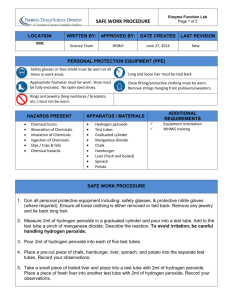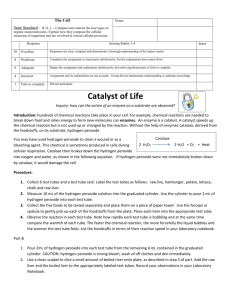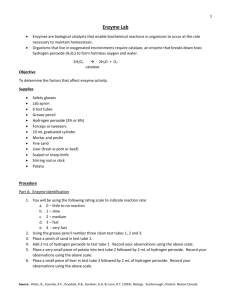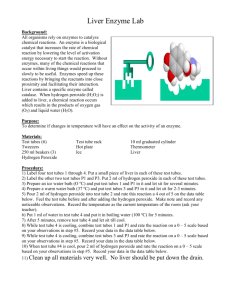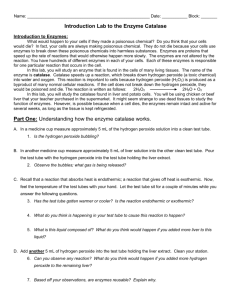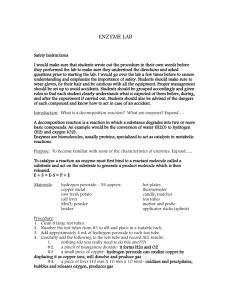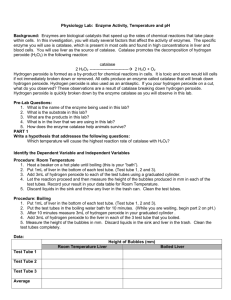SBI 4U Enzyme Lab Catalase
advertisement
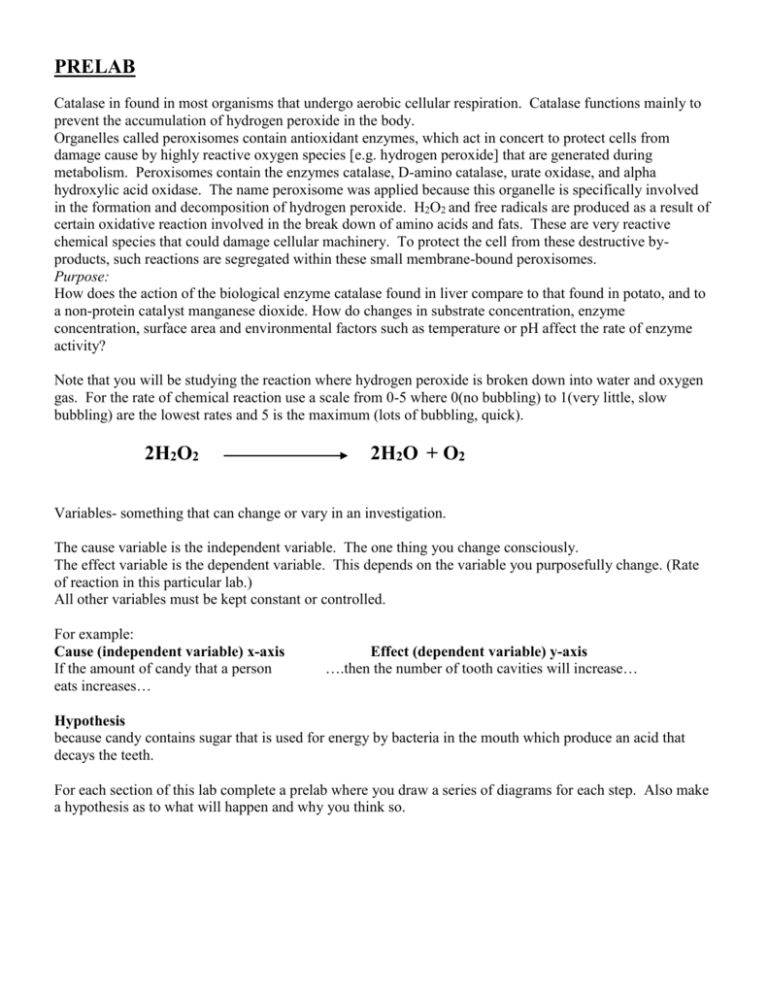
PRELAB Catalase in found in most organisms that undergo aerobic cellular respiration. Catalase functions mainly to prevent the accumulation of hydrogen peroxide in the body. Organelles called peroxisomes contain antioxidant enzymes, which act in concert to protect cells from damage cause by highly reactive oxygen species [e.g. hydrogen peroxide] that are generated during metabolism. Peroxisomes contain the enzymes catalase, D-amino catalase, urate oxidase, and alpha hydroxylic acid oxidase. The name peroxisome was applied because this organelle is specifically involved in the formation and decomposition of hydrogen peroxide. H2O2 and free radicals are produced as a result of certain oxidative reaction involved in the break down of amino acids and fats. These are very reactive chemical species that could damage cellular machinery. To protect the cell from these destructive byproducts, such reactions are segregated within these small membrane-bound peroxisomes. Purpose: How does the action of the biological enzyme catalase found in liver compare to that found in potato, and to a non-protein catalyst manganese dioxide. How do changes in substrate concentration, enzyme concentration, surface area and environmental factors such as temperature or pH affect the rate of enzyme activity? Note that you will be studying the reaction where hydrogen peroxide is broken down into water and oxygen gas. For the rate of chemical reaction use a scale from 0-5 where 0(no bubbling) to 1(very little, slow bubbling) are the lowest rates and 5 is the maximum (lots of bubbling, quick). 2H2O2 2H2O + O2 Variables- something that can change or vary in an investigation. The cause variable is the independent variable. The one thing you change consciously. The effect variable is the dependent variable. This depends on the variable you purposefully change. (Rate of reaction in this particular lab.) All other variables must be kept constant or controlled. For example: Cause (independent variable) x-axis If the amount of candy that a person eats increases… Effect (dependent variable) y-axis ….then the number of tooth cavities will increase… Hypothesis because candy contains sugar that is used for energy by bacteria in the mouth which produce an acid that decays the teeth. For each section of this lab complete a prelab where you draw a series of diagrams for each step. Also make a hypothesis as to what will happen and why you think so. FACTORS AFFECTING ENZYME ACTIVITY You will be studying the chemical reaction where hydrogen peroxide is broken down into water and oxygen gas. This occurs spontaneously at a slow rate but can be made to occur faster with the aid of a catalyst. For the rate of chemical reaction use a scale from 0-5 where 0(no bubbling) to 1(very little, slow bubbling) are the lowest rates and 5 is the maximum (lots of bubbling, quick). 2H2O2 2H2O + O2 Introduction: Your introduction should include a discussion of what a protein is and more specifically what an enzyme is. You should discuss the fact that enzymes are bio-organic and are sensitive to the conditions of the environment. Expand upon conditions of the environment that might affect the biological activity of enzymes. Then specifically expand upon the enzyme being studied in this lab and its function. You can always do a little extra research on the internet Purpose: Materials: 3% hydrogen peroxide 10 mL pipette Crushed ice or snow Test tubes and rack manganese dioxide potato beaker scalpel or knife liver wooden splint hotplate Procedure: PART A: 1. Add 2mL of hydrogen peroxide to two test tubes. To one of the test tubes add a pinch of manganese dioxide and cover the mouth with your thumb. 2. Place a glowing splint into the mouth of the test tube. PART B: 1. Add 2 mL of hydrogen peroxide to two test tubes. 2. Place a small piece of liver into one test tube and a small piece of potato into the other test tube. 3. Keep the test tube with the liver for part C. PART C: 1. Divide the liquid from Part B equally into two test tubes. 2. Cut the liver from Part B into two equal sized pieces and place them into the tubes from step 1. 3. To one of the test tubes add a small piece of fresh liver and to the other tube add 1 mL of fresh hydrogen peroxide. PART D: 1. Chop up a small piece of liver and a small piece of potato and place the bits into two test tubes of hydrogen peroxide. 2. Add 2 mL of hydrogen peroxide to two test tubes. PART E: 1. Place a small piece of liver in a test tube and heat for 5 minutes in a boiling water bath. Place another small piece of liver in a test tube in a 37oC water bath for five minutes. In a third test tube place a piece of frozen liver in an ice water bath for 5 minutes. 2. To the frozen liver add 2mL of cold hydrogen peroxide. To the other two test tubes add hydrogen peroxide at room temperature. Data Table for Factors Affecting Enzyme Activity PART CATALYST A MnO2 B LIVER OBSERVATIONS RATE OF REACTION POTATO C USED AND FRESH LIVER USED LIVER AND FRESH H2O2 D CRUSHED LIVER CRUSHED POTATO E FROZEN LIVER LIVER 37oC BOILED LIVER Discussion: 1. Identify the gas that was produced in each of these reactions and support your answer. 2. Write a balanced chemical equation for the decomposition of hydrogen peroxide. Don’t forget to include special conditions. 3. Compare the results in Part D with those in Part B and explain any differences. 4. What is the effect of temperature on enzyme activity? 5. The body temperature of a chicken is approximately 40oC. Would your results be different if you had used a piece of chicken liver for this investigation? (Note: body temperature of a cow is around 38oC) 6. All of these reactions were conducted at a pH close to 7.0. Predict how your results may have differed if the same experiment was conducted at pH 2.0 and at pH 10.0 and give a rationale for your prediction. PART A B CATALYST MnO2 LIVER POTATO C USED AND FRESH LIVER USED LIVER AND FRESH H2O2 D CRUSHED LIVER CRUSHED POTATO E FROZEN LIVER LIVER 37oC BOILED LIVER INTERPRETATION/EXPLANATION PRELAB PART DIAGRAM RATING AND PREDICTION A B C D E I predict the tube with the liver will have a more vigorous reaction [rating = 5] than the tube containing the potato [rating = 2]. Because I think liver cells would contain more of the enzyme catalase than potato cells. With more enzyme molecules available, more hydrogen peroxide can be decomposed at a faster rate. I think liver cells contain more catalase than potato cells because the liver is an organ of the body which detoxifies the blood and which would decompose harmful hydrogen peroxide into harmless products of oxygen and water. Potatoes are merely storage sites for starch and wouldn’t have as much of a detoxification role.



